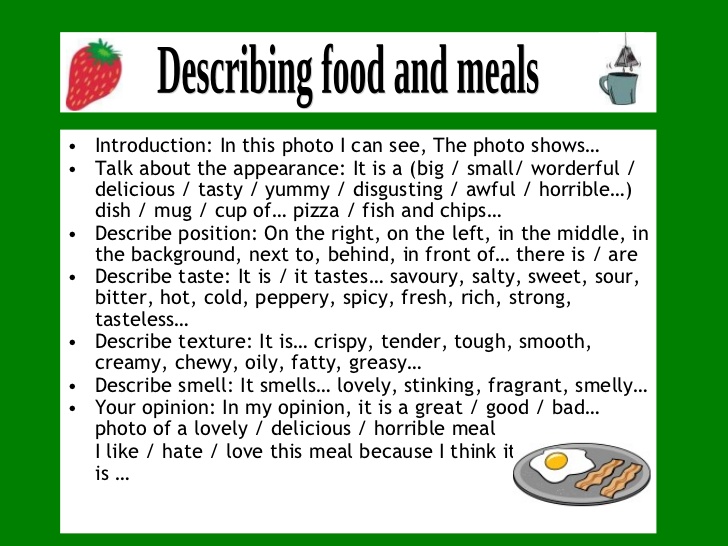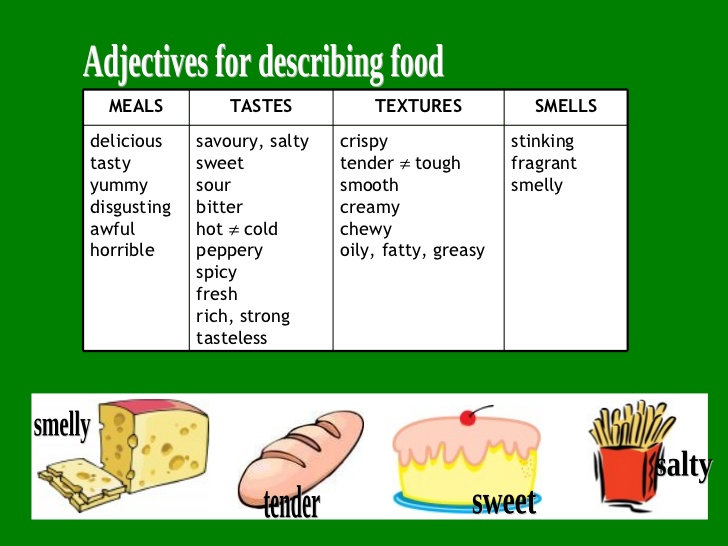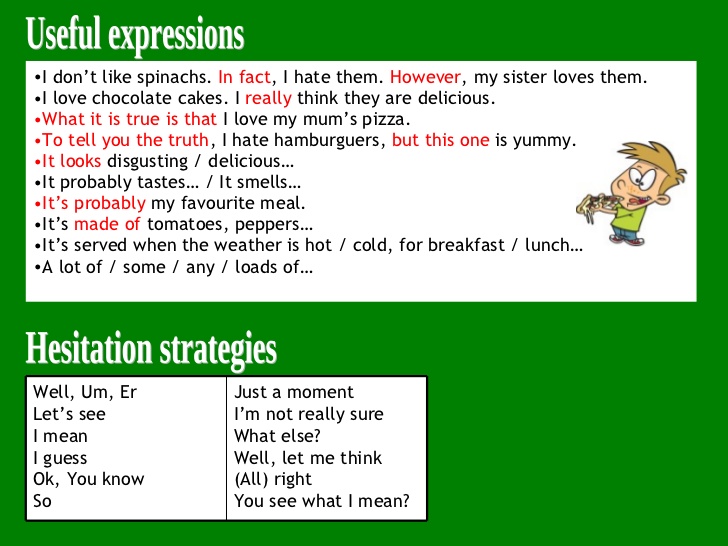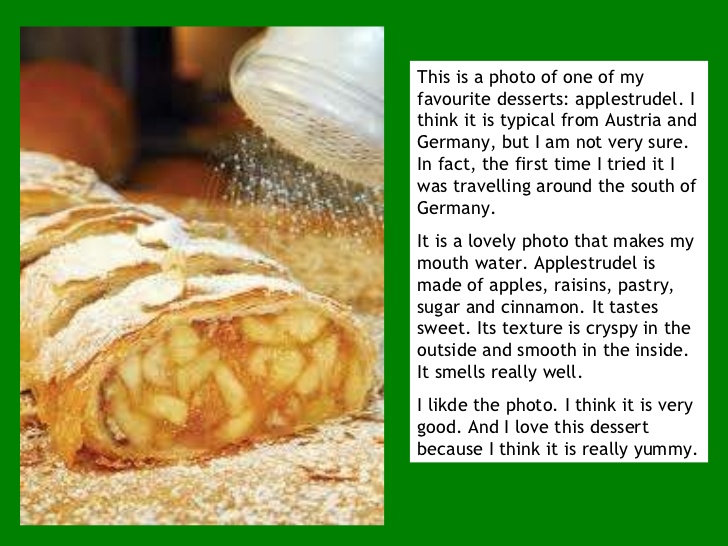English Adjectives Describing food
Describing food is not as easy as it would seem. How many ways can you say something was really tasty? Not enough to keep you interested in what you are writing. That is why we have to borrow words from other areas to describe the food and the effect it has on us.
You can compare a dish to a picture, a sports game, a musical performance or give it personality. Describe its sunny or somber mood, shyness, assertiveness, or contradiction of flavors. Knowing the words for describing tastes and flavors will help you to find the right adjective in other areas.
Describing taste and flavor
Acerbic is anything sour, bitter or sharp – cutting, caustic, acid, mordant, barbed, prickly, biting, pointed. The opposite flavor would be mild, sweet, or honeyed.
Acid or Acidic food can be sharp, tart, sour, bitter. Just the opposite of sweet, sugary, honey.
Acrid taste can be considered pungent, bitter, choking, sharp, unpleasant, harsh – sharp, cutting, caustic, bitter, vitriolic, mordant, trenchant – sour, tart, sharp, biting, acerbic.
Aftertaste is the trace, hint, smack, relish, savor food leaves behind.
Ambrosia is the food of the gods, and epicurean delight, food fit for a king, delicacy, heavenly spread, gastronomical delight, some apply this term to the pièce de résistance in a meal.
Ambrosial is, therefore, fit for the gods, delectable, mouthwatering, heavenly, savory, delicious, tasty, toothsome, divine. It is not distasteful or disgusting at all.
Appealing food is attractive, tempting, interesting, pleasing, alluring, likable, engaging, charming, fascinating, glamorous. It is never repulsive, disgusting, or repellent.
Appetite is the hunger, craving, desire, taste, ravenousness, sweet tooth, thirst, penchant, or passion we experience. When we have an appetite for something, we don’t find it revulsive, repulsive, or distasteful.
Appetizer is the tidbit, snack, starter, hors d’oeuvre, finger food, dip, cold cuts, kickshaw, olives, anchovies – canapés, dim sum, aperitif, rollmops, antipasto, crudités we might have to open a meal.
Appetizing is everything we find appealing, mouth-watering, delectable, savory, delicious, palatable, inviting, tantalizing, toothsome, luscious, tempting, tasty, enticing. Opposed to what we find nauseating, sickening, repulsive, unappetizing, revolting.
Astringent is biting, harsh, sharp, cutting, acerbic, severe, rough, acrid, mordant, caustic. It is not mild, soft, gentle.
Balsamic comes as soothing, balmy, mild, gentle, temperate, tranquil, calm. Never irritant or abrasive.
Biting taste means caustic, piercing, penetrating, stinging, sharp, severe, mordant, stinging. It is not gentle, balmy, or soothing.
Bitter is acrid, tart, sour, harsh, acidic, vinegary, acerbic. The opposite of sweet, honeyed, mild, gentle, warm.
Brackish means salty, briny, saline.
Briny, almost the same as the previous word, salty, brackish, saline.
Caustic is something cutting, biting, acid, acidic, sharp, astringent, stinging, scathing, excoriating. To say the opposite you would call it mild, sweet, or smooth.
Choice can mean selection or pick, but in relation with food -like a choice steak- means more often superior, excellent, select, top-notch, fine, first-rate, high-quality, cream of the crop, vintage, prime. second rate.
Delectable food is delicious, tasty, mouth-watering, appetizing, scrumptious, luscious, enjoyable, palatable, delightful, toothsome, pleasing, satisfying. Never tasteless, disgusting, or nauseating.
Delicious meals are tasty, appetizing, scrumptious, yummy, luscious, delectable, mouth-watering, fit for a king, delightful, lovely, wonderful, pleasant, enjoyable, appealing, enchanting, charming. You wouldn’t call delicious that what is tasteless or unpleasant.
Divine cooking is fit for the gods, heavenly, godly, celestial, great, marvelous, delightful, lovely, blissful. Nothing earthly.
Dry food can be desiccated and withered like an old prune. Sometimes dry food keeps better, as beans and pulses; then being dry is a desirable trait. The dry weight –the solid part- in canned food gives you an idea of the real nutritional value. But most times dry food is juiceless and tasteless, lacking moisture -it will need a sauce. Food with a sharp, biting taste, or with a high proportion of strong alcohol is also dry. Food eaten without any spread, sauce or garnish would be eaten dry. Overcooked meat gets dry, having lost all juices.
Dulcet is sweet, honeyed, pleasant, in a gentle way, something in harmony with your taste or likings. It is never harsh.
Dulcified is what has been made sweeter, or softer, in taste, edulcorated, sweetened.
Flavored equals seasoned; food that has been given flavor, by normal seasoning or by artificial flavoring. Which flavor? Any, but by being flavored, it is sure to give some kind of taste experience.
Flavorful, obviously full of flavor, or you could say, instead, flavorsome, tasty, tangy, appetizing, palatable, savory or sweet -for a particular flavor- and, if you want to try less known words, sapid or saporous. It wouldn’t be flavorless, tasteless, bland, flat, or insipid.
Flavoring or seasoning, anything added to food for the flavor it imparts or the act of adding flavor to food. Think of herbs, spices, condiments, seasonings, or some food additives as different flavorings.
Flavorsome indicates good tasting, full of flavor, specifically pleasant flavor; implying delicious, tasty, appetizing, scrumptious, yummy, juicy, succulent, heavenly, inviting, luscious, mouthwatering, palatable, saporous, savory; may be divine, toothsome, and tempting. Consider flavorsome just the opposite of distasteful, nauseating, repulsive, sickening, unappetizing, unsavory.
Fruity food will be having a taste, smell or flavor of fruit; anything tasting or smelling richly of or as of fruit. A wine full of fruity flavors will probably be considered concentrated, full-bodied, full-flavored, heady, heavy, lusty, mellow, potent, redolent, rich, strong, well-matured.
Full-bodied -usually applied to wine- means robust, or rich and intense flavor and aroma; it would be a wine that feels heavy in the mouth.
Gamy refers to the flavor or strong odor of game, especially game that is starting to spoil. It would be malodorous and rancid, certainly not fresh. It is a word more often applied to other areas than to food.
Gustatory, relating to the sense of taste, to the sensation in the taste buds.
Harsh, unpleasant to the taste, abrasive, coarse, acerbic, astringent, biting, bitter, caustic, cutting, dry, mordant, nasty, sharp, stinging, vitriolic. Definitely not smooth.
Heavenly, considered divine, wonderful, blissful, delightful, lovely, fantastic, glorious, sublime; opposed to horrible and dreadful.
Honey, honeyed and let us say sweet, sugar, sweetened, sugarcoated, syrupy, candied. Never harsh, acerbic or salty flavor.
Hot as in burning, scorching, boiling, blistering, sizzling, searing, blazing, torrid; or hot as in spicy, peppery, piquant, pungent, so strong flavored that makes one feel burning, fiery, intense, vehement, ardent, fervent flavors – definitely not cold, mild, soft or tasteless.
Juicy food is succulent, luscious, thirst quenching, moist, ripe, usually flavorful, many times fascinating. Dry and bland don’t apply.
Luscious food and we are talking juicy, moist food; delicious and delectable food; scrumptious or succulent food; super tasty, toothsome, more than palatable, surely mouthwatering food. Dry, disgusting or nauseating? No way!
Lush would be a rich, lavish, opulent meal; sumptuous, luxurious, certainly abundant. You would not be presented with sparse food, a scanty meal or a thin plate.
Mellow flavor is smooth, rich, full, soft, or melodious; usually a pleasant, fully developed flavor reached after an adequate aging period. In this sense of matured, softened, developed flavor, is often used when writing about cheese or wine. But it could be used perfectly for preserved or canned food, or to describe a particularly rich dish. Mellow is opposite to harsh.
Mouthwatering is that savory, flavorful, succulent, gorgeous, delicious food which gets you salivating; by no means unappetizing or distasteful.
Nectarous stands for ambrosial, delicious or sweet; something that reminds you of nectar, the drink of the gods –in Greek mythology, therefore it would seem more to the point using it for liquids than for solid food. Any sweet, stimulating drink could be nectar to your lips.
Palatable indicates edible, pleasant, tasty, just OK, appetizing, toothsome, I would not say delicious. Palatable food is acceptable to the palate, something in between mouthwatering and foul. It is NOT inedible, tasteless, or disgusting either.
Say peppery and piquant comes to the mind. Others could think of gingery, spicy, hot, fiery, sharp, stinging, pungent or somehow lively and strong. Tasting like pepper, no one would think it mild.
Pickled would account for that briny flavor that food preserved in a pickling liquid gets. Food is pickled, marinated or cured –pickling would prevent from spoiling- in some liquid with plenty of salt, vinegar, or similar, and spices.
Piquant and salty, savory, spicy, tasty or zesty are very similar words. Also to be considered having a pleasant pungent taste, hot, tangy, agreeably biting or sharp; never bland or insipid.
Pungent can be seen as strong, spicy, hot, heady, overpowering, sharp, biting, a penetrating taste or smell; or you could take it by the forceful, biting, cutting, caustic, acerbic side. Forget about bland or mild.
Rancid food is bad, stale, rotten, completely off; the opposite of fresh food.
Rank means pungent but in the fetid, smelly, foul, stale, rancid, definitely bad way; offensive to the smell or taste and not fresh.
Rich food is full, heavy, dripping, full-bodied, robust; a rich table is plentiful, abundant, loaded, ample, copious, stuffed. None of them is lacking or plain.
Saccharine is another way to say sugary, syrupy, maybe treacly; certainly it’s overly sweet and opposite to bitter.
Saline or salty could almost be used without distinction or they could be substituted by briny or brackish because both contain salt. Salty food is sure to be savory. Remember, salty is one of the basic tastes.
Sapid, saporific, or saporous are certainly full of flavor; that is to say flavorful, flavorsome, flavorful, flavorous. Better not pronounce, just write; those are not every day words
Savory has flavor. Which one? It might be salty, spicy, pungent, sweet or plainly aromatic and flavorful, but the taste would be pleasant and agreeable.
Scrumptious is shouting “eat me!” It is delicious, delectable, mouthwatering, tasty, delightful, gorgeous, lip smacking, yummy, wonderful in taste and aroma; never unappetizing, unappealing, or tasteless. Think of a scrumptious pie is very appetizing, pleasing to your taste; your sense of taste.
Sec is another way to say medium dry, un-sweet. This word is borrowed from wine world.
Sharp incisive, harsh, sour, tangy, acid, pungent, tart, bitter; it could be acerbic or astringent, but it is not bland.
Sour is one of the basic tastes. It is acid, lemon-like or vinegary, tart, bitter, acerbic. Sour food has a sharp biting taste and, certainly, is not sweet.
Spicy food has the piquant, hot, fiery, burning taste of spices. We are talking of highly spiced, piquant, zesty food, certainly savory. It can be also described after the predominant spice, like peppery or gingery food. This is the complete opposite of mild food.
Strong tasting food is highly flavored i.e. highly seasoned; concentrated flavor, intense, pungent, and as such piquant, hot, spicy and sharp, with an intense aroma. The flavor is never weak or faint. A strong wine is high in alcoholic content.
Succulent food is juicy, moist, tender, lush, luscious food; usually sweet tasting and the opposite to dry, flavorless food.
Sugary or sweet means syrupy, candied, sugar coated, honeyed, sweetened, sugared, maybe saccharine; opposite to bitter, unsweetened or sugarless.
Sweet-and-sour, a Chinese specialty and also said of a dish that has a pleasant taste and a bitter or sharp touch in contrast.
Sweetened or syrupy are other ways to say sweet, sugared, candied, honeyed, sugar coated
Tang applied to food refers to a tart spiciness. Describe it as that taste experience which leaves the tongue tingling after taking food to the mouth. Flavor, relish, savor, smack, zest, tanginess, piquancy, nip, all those words can be written in place of tang. Bland or dull food is just the opposite.
Tart sharp, sharp-tasting that is, bitter, acid or acidic, harsh, sour taste, just like a lemon. Sweet, honeyed and the like words are the opposite.
Tasteful or full of flavor, flavorful, food; it could mean refined, sophisticated, stylish or classy when it refers to the layout of a dish –the realm of a food stylist; the opposite? The answer is tasteless.
Tasteless is the opposite of tasteful or tasty. We are talking bland, flavorless, flat, insipid, weak, dull, savorless, plain, unseasoned, unsavory, unflavored, probably unappetizing food.
Tasting, sensing and distinguishing food by means of your taste buds. A tasting will usually mean a small sample of wine or food. To have a tasting means taking a small amount of food or wine to test its quality. But, sometimes, the only way to describe food is to say food was good tasting, or it tasted foul.
Tasty and by association… yummy! It is delicious, flavorsome, full of flavor, appetizing, scrumptious, probably fresh and juicy, making a succulent meal, a kid would say finger licking good. Apply to food and dishes full of bite, piquancy, zing, zest and relish. It will never be dull or tasteless, disgusting, gross or nauseating.
Toothsome, strictly used, refers to edible and pleasant food, or you could even write tasty, appetizing or delicious instead, something really pleasant to the sense of taste. But you will see it very often meaning healthy food, good tasting food that has something more than good taste going for it. The opposite will be inedible, tasteless, disgusting or foul… yucky!
Treacly is sweet but overly so, syrupy and saccharine to the point of being disgusting.
Unsweetened or no added sugar, no added sweet flavor; probably sugarless, plain or bitter in taste, but not always. Unsweetened tea is not to everyone’s taste but unsweetened fruit juices are perfect, as there is no need to add any sweetener to something it is already sweet. Opposites are sweet, saccharine, or syrupy.
Food with a vinegary flavor would taste like vinegar. It would be acetous, sour, acid, acidic, tart, astringent, pungent, harsh, acrid; never sweet.
Yummy food is scrumptious, delicious, delectable, luscious, great tasting, much more than tasty, really appetizing, lip-smacking; the kind of food to have you licking your lips in anticipation. This is the word everyone wants to hear when bringing food to the table. Yummy food is never unpalatable, plain tasting, distasteful or disgusting.
Zesty food has a vivid, spicy, piquant, utterly savory flavor; feels invigorating, stimulating, fresh and reviving. Food with a zesty flavor never soothing or dull; this is exactly the opposite.
Hope you liked this Post and it is very helpful to you.
You can join Radix Tree Online Classes to enhance and improve your vocabulary which is going to help you in daily life and official work environment.





